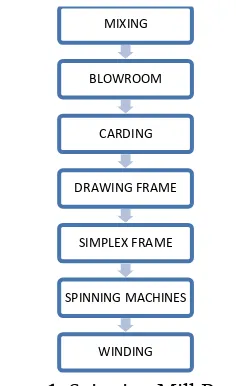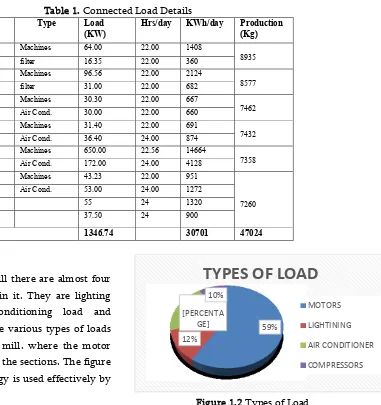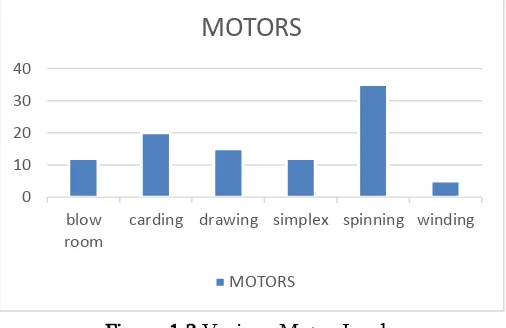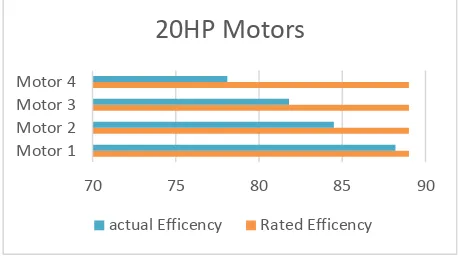CSEIT1833517 | Received : 01 April 2018 | Accepted : 10 April 2018 | March-April-2018 [ (3 ) 3 : 1358-1363 ]
© 2018 IJSRCSEIT | Volume 3 | Issue 3 | ISSN : 2456-3307
1358
Energy Efficiency and Analysis of Motors in Spinning Mill
Kiruthika R*, Benedict Joy, Raghul Prasanth D, Siju V
Department of EEE, Info Institute of Engineering, Tamil Nadu, India
ABSTRACT
Energy audit is systematic and methodological approach to identify and check the usage and wastage of input energy and hence attempts are made to adjust and reduce the energy requirements. In this cotton spinning mill motors of three phase induction motors contribute to more than 75% of the total electrical load. Due to its ruggedness and versatility the three phase induction motors are used in it. Loss of motor efficiency with operation and time is a very common problem in every industry, not only in this industry every other industry faces these challenges every day. This paper deals with scope of energy savings by improving the power factor and thereby increasing the efficiency of motors by energy audit analysis in Spinning mill. A comparison is also being studied and analysed for efficiency of old motor with energy efficient motor that would be useful in finding the areas where the energy can be saved, scope for saving of energy, cost, CO2 emission by replacing
this old rewound/faulty motors with energy efficient motors so the electrical energy can be significantly reduced up to 10%-15% with more efficient components.
Keywords: Spinning mill, Three Phase Induction Motor, Motor Efficiency, Energy Savings, Old Motors
I.
INTRODUCTION
In Spinning mill, electricity consumption and power cost is in increasing trend due to modernized machines and continuous usage of the machines in inefficient operating parameters. So, energy audit is being done studied and thus they are analyzed in order to save the energy in the spinning mill. In any industry, the three major operating costs include energy (electrical and thermal), labor and materials. Among these, the cost of energy is rated at the top Hence, spinning mill machinery manufacturers are integrating automation in the machines, indirectly requirement of power of the machines is increased. Areas of energy losses are identified; suggestions for cost effective measures to establish efficient energy use and estimation of implementation costs and payback periods are calculated and discussed. Improved energy performance and reduced energy consumption is explored to assist the possible elimination of energy crisis through energy management.
Spinning Industry in India is one of the vital components of the Indian economy and contributing around 13%. of total industry production, about 4% of India’s Gross Domestic Product (GDP), about 16% of the gross export earnings and employing about 35 million people being the second largest provider of employment after agriculture. Taking the installed capacity of spinning machinery only, it ranks second (with 19.7% of total spindles globally), after China. In spinning industry, electricity consumption and power cost is in increasing.
integrating automation in the machines, indirectly requirement of power
II.
PROCESS IN SPINNING MILL
The process of spinning mills consists of different sections. Different types of cotton are mixed in mixing section; fibres made are sent to blow room to clean, blend, remove micro dusts and to provide uniform feed to the carding machine; which separates and cleans cotton fibres for spinning. In spinning, yarn is made from cotton fibres by drawing out and twisting into a thin strand. Finally, winding is wound on the rolls for the required lengths. So different types of process are explained and the process layout is thus shown below in the fig 1.1 so we can get the clear idea about the process or the areas of the spinning mill industry.
It consists of different other sections like mixing at first, Mixing is the first and foremost important process in the spinning process. Mixing is a process by which different grade of same fiber are kept together. And then comes into the blow room where the supplied compressed bale is turn into a uniform lap of particular length by opening, cleaning, blending or mixing, and the next important section is the carding during this carding process, two surfaces of wire or metallic card cloth, moving in the same direction but at different speeds on the card machine, comb the cotton into a fine web of generally parallel fibers and then next comes to the drawing frame and simplex frame where thus the six carded cotton is being made into one simplex material. Spinning machines is the next section to be carried out after the simplex frame thus there now many automation machines being carried in it. The final thing is made into a yarn or to a spindle this may be called as a winding. So these are the process that we can see in any cotton spinning industry.
Figure 1. Spinning Mill Process
III. ENERGY AUDIT METHODOLOGY
An energy audit is a survey or inspection that analysis the energy flows for energy conservation in a building, process or system to decrease the amount of energy input into the system without affecting the output. It will show where the power consumption is more in the given system. It can also be called as controlling of the power to avoid losses for maximize efficiency.
ENERGY AUDIT = SAVINGS IN MONEY +
ENVIRONMENTAL PROTECTION +
SUSTAINABLE DEVELOPMENT
Nowadays people are more concerned about energy efficiency, energy consumption and energy conservations in buildings. Energy audit is considered as the one of comprehensive methods in checking the energy wastage and usage in buildings. This paper presents the preliminary study of energy audit that has been conducted in spinning mill.
A. Objective of Energy Audit
In any spinning mill, the top most operating cost would be energy both electrical and of thermal, labor and of materials. If one were to relate to the manageability of the cost or potential cost savings in each of the above components, energy would invariably emerge as a top ranker, this energy management function would constitute a strategic area for cost reduction. Energy audit will help to
MIXING
BLOWROOM
CARDING
DRAWING FRAME
SIMPLEX FRAME
SPINNING MACHINES
understand more about the ways energy and fuel are used in any industry, and help in identifying the areas where waste can occur and where scope for improvement exists. The energy audit would give a positive orientation to the energy cost reduction, preventive maintenance and quality control programmes which are vital for production and utility activities. Such an audit programme will help to keep focus on variations which occur in the energy costs, availability and reliability of supply of energy, decide on appropriate energy mix, identify energy conservation technologies.
B. Types of Energy Audit
There are almost three types of energy audit being conducted in any other industry depending upon the type of load and any other proceedings they are varied and thus the types are preliminary audit, general audit and investment grade audit. The preliminary audit alternatively called a simple audit, screening audit or walk through audit, is the simplest and quickest type of audit. whereas the general audit alternatively called a mini-audit; site energy audit or complete site energy audit expands on the preliminary audit described above by collecting more detailed information about facility operation and performing a more detailed evaluation of energy conservation. In most corporate settings, upgrades to a facility's energy infrastructure must compete with non- energy related investments for capital funding. Both energy and non-energy investments are rated on a single set of financial criteria that generally stress the expected return on investment. Thus the type of Audit depends upon the
Function and the type of industry selected
Depth of final audit is needed, and
Magnitude and the potential cost reduction desired
C. Methodology
In Energy auditing the methodology for the detailed audit is thus described and thus they are explained in detail about the steps to be taken care thus the
detailed energy auditing is carried out in three phases: Phase I, II and III.
Phase I – Pre-Audit Phase Phase II -Audit Phase Phase III –Post-Audit Phase
In the Phase I Pre Audit phase a structured methodology to carry out an audit is necessary for efficient working. An initial study of the site should always be carried out, as the planning of the producers necessary for an audit is most important.
In Phase II the audit report will include a description of energy inputs and product outputs by major department or by major processing functions, and will evaluate the efficiency of each step of the manufacturing process. Means of improving these efficiencies will be listed, and at least a preliminary assessment of the cost of the improvements will be made to indicate the expected payback on any capital investment needed.
The audit report should conclude with specific recommendations for detailed engineering studies and feasibility analyses, which must then be performed to justify the implementation of those conservation measures that require investment.
Whereas for the Phase III audit the detailed analysis is made and thus analyzed for the Post audit phase taking up the detailed analysis of the action plan and scheduling the implementation process.
D. Energy Audit Equipment’s used
There are some equipment’s used for the energy auditing without that the detailed analysis cannot be made or done properly. So these are the equipment’s used in Energy auditing in any industry other than spinning mill
Load manager meter
Lux meter
Power Quality analyser
Tachometer
Digital clamp meter
Combustion Analyser
Gas leak detector
IV. OBSERVATION
The source of energy to the Spinning mill is from the nearby substation located near to it by the electricity board. It has four distribution transformers with different KVA one is 800KVA and the other three is of 500KVA. And there are different Genset of different KVA in it. The power capacitors are also being installed in it to improve the power factor and there are almost 9 capacitor banks in it of 100KVAR.
A. Energy Flow in Spinning Mill
The flow of energy is so simple but not like our residential buildings it is first from the Substation i.e.
of 22KV substation and then next it goes to the Transformers as we mentioned above it of four transformers and next to the MV Panels and then to the SSBs of each sections and thus finally to the loads like lighting, motors, drives, conditioning units and many others connected to it
B. Connected Load Details
Various departments like blow room, carding, drawing, simplex, spinning and winding their installed capacity and thus their load used for a day is thus calculated in order to see the production of spindles per day. In each department the type of load like machines or filter or air conditioning is thus added to see the load details and how they are consumed for a day and their production for a day is also being calculated and thus listed in the table1
Table 1. Connected Load Details
Department Type Load
(KW)
Hrs/day KWh/day Production (Kg)
spinning Machines 650.00 22.56 14664
7358
Basically, in this spinning mill there are almost four types of load is being used in it. They are lighting load, motor load, air conditioning load and compressors. So these are the various types of loads being used in this spinning mill. where the motor load is being used more in all the sections. The figure 1.2 shows that how the energy is used effectively by various load.
So the motor load is being used is of 59% for various sections in the spinning mills. where a detailed analysis is done to check where the motor load is being used effectively in which section. Thus the use of compressors is about 10%, Optimize air consumption & pressure for cleaning air application (this is one of the largest wastage in most of the textile industries) Have effective controls on the operation of the compressors for better optimization & sequencing. In which the air conditioners are about 19%. where air conditioning is the process of treating air also as to control simultaneously its temperature, humidity, cleanliness and distribution to meet the requirements of "conditioned space". An air conditioning system may use heating, cooling, humidifying, de-humidifying and filtering units of combination of these depending upon the outside weather. Lighting is about 12% in which collecting all the details of the tube light there all together 900 plus tube lights are being used for the entire departments.
The motors used is of all the sections in the spinning mills so the energy used for the different motors is illustrated in the form of a graph and it is shown in the figure 4.6. so the detailed analysis for each department like blow room it uses around 11 motors and thus for the carding it is used around 23 motors and for drawing we have 13 motors connected to the machines, after that 11 simplex motors are being connected to the machines. After this the main area or section of spinning section is gone it is around 27 motors being used in it, and for the winding or auto cone machine the motors used is of 11 motors. Thus the detailed consumption of energy is illustrated in the form of a graph in the figure 1.3 and it is shown below
Figure 1.3 Various Motor Load
V.
INDUCTION MOTOR
About 60% of this industrial load is induction motor load. While Comparing with the other alternatives the induction motor is cheaper and easier to maintain. The induction motor is made up of stator, which is a stationary part in the motor, and thus the other one is rotor the rotating part in the motor. The stator consists of a series of fine wire windings of very low resistance permanently attached to the frame of the motor. A magnetic field is developed in the windings as a voltage and a current is applied to the stator winding terminals. By the way the stator windings are arranged, the magnetic field appears to synchronously rotate electrically around inside of the housing of the motor. And commonly used prime mover for various equipment’s in industrial applications is induction motors.
A. Methodology
Thus the energy audit in the induction motors has some methodology to follow up in order to get a clear picture about the type of audit we are going to conduct, and thus the flowchart for the two different motors like one it is of energy efficient motors and other of old or rewound motors is listed how to do the energy audit is illustrated and thus given in the Figure1.4
0 10 20 30 40
blow room
carding drawing simplex spinning winding
MOTORS
Figure 1.4 Steps for Comparing Two Motors
B. Calculation of Motor Parameters
The calculated motor parameters are those the formulas for using to calculate the losses or the rated or the actual efficiency of the motor so the formulas are enlisted and given below
Synchronous Speed (Ns) = (120 X f) / P
Percentage Slip at No Load (%S) = (NS—NL)/ NS*100
Percentage Slip at Full Load (%S) = (NS-NFL)/ NS*100
Stator resistance at no load (R) = R0 (1+αt)
Stator resistance at full load (R)= R0 (1+αt)
Stator Copper Loss at No Load Cu loss = I2No Load*R
Stator Copper Loss at full load Cu loss = I2Full Load*R
Iron Losses = Input Power-Stator Cu losses at No-load
Rotor Input power = Full load Input power-stator Cu losses - Iron losses
Full load rotor losses = s*p2
Stray losses are 1.5% of the full load
Full load output power = Full load input power - stator Cu losses – Iron losses - stray losses- full load rotor losses
Percentage loading = (Full load output power / Rated power) *100
Power factor at full load = Full load o/p power/ 1.732*full load voltage* full load current
Efficiency=Full load output power/ full load input power) *100
Rated efficiency = HP.*746/rated power in watt) *100
VI. ANALYSIS
The analysis for the old rewound motor for all the rated efficiency and their actual efficiency is thus analyzed, compared and thus the graph for the various HP motors is thus drawn. So we can the change the motor to a new and efficient motor by replacing the old motor. Thus the values taken is of practical and of theoretical values to determine the savings analysis in it.
A. Analysis of Old and New Motor
Use of high efficiency or Energy efficient motors. The energy efficient motors have reduced losses through improved design, better materials and improved manufacturing techniques. Whereas the simple calculation is doing and thus the table is illustrated below to the new and old motors and it is shown in the table 2 below,
Table 2. Comparison of Old Motor Vs New Motor
Motor KW Efficiency
(%)
Loading (%)
Req. Input (KW) Old
motor
373KW 89% 80% 335.28
New motor
373KW 95% 80% 314.10
KW Savings 21.18
Figure 1.5 Comparison of Old Motor Vs New Motor
Thus it is evident that the old motor has less efficiency compared to the new motor so if we calculate the Kilo Watt Savings thus for the new Analysing For Energy Savings
Comparing Their Efficency Selection of New Motor Measuring Motor Parameters
Selection of Old Motor
0 100 200 300 400
motor the savings will be less so we can save the energy up to 5%. This is only for the one motor if u thus compare with the all motors and thus calculate the savings it can be around 20% of energy savings in a month.
B. Analysis by their Efficiency
This type of analysis is done in order to find the old or rewound motor and to change the motor to a new and efficient motor. This is checked by finding its rated efficiency and of the actual efficiency so thus they are being compared and find out the drop of efficiency in the motor and they are changed to the new one. In this spinning mill there are different types of motors like 10HP motors, 15HP motors and more depending upon the machine they are changed. At first 10HP motors are studied and thus the parameters are given below in Table 3
Table 3. Parameters of 10HP Motors
Motors 1 2 3 4
Rated
Efficiency(%)
89 89 89 89
Actual Efficiency(%)
85.0 84.2 75.8 82.1
Figure 1.6 Analysis of 10HP Motors
It is clear that for the 10HP motors in the figure 1.6 the motor3 has the actual efficiency is of low compared to the other three so we need to change the motor to the new and efficient motor Now the analysis for the 15HP motors are analyzed and thus the data is illustrated in the table 4
Table 4. Parameters of 15HP Motors
Motors 1 2 3 4
Rated
Efficiency(%)
89 89 89 89
Actual Efficiency(%)
86.3 84.5 79.8 77.1
Thus the analysis for the 15HP motors is analyzed and thus the graph for it is shown in Figure 7 and it is evident that for the motor 3 and motor 4 the rated efficiency is low compared to the other so there we have to change to a new motor for savings.
Figure 1.7 Analysis of 15HP Motors
Next is the analysis for the 20HP motors with the rated efficiency and of the actual efficiency thus their table is shown in the below table 5
Table 5. Parameters of 20HP Motors
Motors 1 2 3 4
Rated
Efficiency(%)
89 89 89 89
Actual Efficiency(%)
88.2 84.5 81.8 78.1
It is clear that for the motor 3 has the rated efficiency is of low compared to the other three motors in the figure 8 so changing that to the new and efficient motor its actual efficiency gets high so thus energy can be saved.
65 70 75 80 85 90
Motor 1 Motor 2 Motor 3 Motor 4
10HP Motors
actual Efficency Rated Effeciency
70 75 80 85 90
Motor 1 Motor 2 Motor 3 Motor 4
15 HP Motors
Figure 1.8 Analysis of 20HP Motors
VII.
RECOMMENDATIONS
Use of Cogged V-belts instead of V-belts is thus recommended to use
Properly size to the load for optimum efficiency. (High efficiency motors offer of 4 - 5% higher efficiency than standard motors)
Use energy-efficient motors where economical.
Use synchronous motors to improve power factor.
Check alignment.
Provide proper ventilation (For every 10 0C
increase in motor operating temperature over recommended peak, the motor life is estimated to be halved)
Check for under-voltage and over-voltage conditions.
Balance the three-phase power supply. (An imbalanced voltage can reduce 3 - 5% in motor input power)
Demand efficiency restoration after motor rewinding. (If rewinding is not done properly, the efficiency can be reduced by 5 - 8%)
VIII. CONCLUSION
In this paper it is concluded that the use of old motor may have less efficiency and more energy losses so in which thus changing to the new and efficient motor it thereby increases the efficiency for the motor, where the initial investment may consume little less amount and thereby giving less losses in the machines. In the present time energy price goes high
day by day as compared to the equipment price such as motors. Even new motors consume 4 to 5 times energy of its initial price in one year and improperly rewound motors consume 6 to 8-time energy in one year as compared to its price and rewound motor consume 2.5 to 3 times more energy than new motor. So we concluded that the difference between the prices of purchase for new and rewound motor is very less, but rewound motors consume much more energy as compare to new motors
IX. REFERENCES
[1]. Richter Eike,Miller Timothy J.E,Neumann Thomas W,Hudson Thomas L,"The Ferrite Permanent Magnet AC Motor-A Technical and Economical Assessment",IEEE Transactions on Industry Applications,VOL. IA-21,NO. 4,May/June 1985,PP 644-650
[2]. Binns D.F.,"Comparative costs of energy losses in induction Motors",Electric Power Application IEE Proceedings,Vol. 134,Pt. B,No. 4,July 1987,PP 177-182
[3]. Medarametla J. B,Cox M. D,Baghzouz
Y,"Calculations and Measurements of the Unity Plus Three-Phase Induction Motor",IEEE Transactions on Energy Conversion,Vol. 7,No 4,December 1992,PP732-738
[4]. Gray Gerald G,Martiny Walter J,"Efficiency Testing of Medium Induction Motor a Comment on IEEE Std 112-1991",IEEE Transactions on Energy Conversion,Vol. 11,No. 3,September 1996,PP 495-499
[5]. Jalilian A,Gosbell V. J and Perera
B.S.P,"Performance of a 7.5 Kw Induction Motor Under Harmonically Distorted Supply Conditions",Electrical and Computer Engineering,2000 Canadian Conference on vol.1,2000,PP 355-359
[7]. Ashfaq Haroon et al,"A new formulation for
minimum input volt-ampere (VA)-Slip
relationship of three-phase induction Motors",Journal of King Saud University - Engineering Sciences (2015)",6 October 2015,PP 1-4.
[8]. Grewal Gurinderbir Singh and Rajpurohit Bharat Singh,"Efficient energy management measures in steel industry for economic Utilization',Energy Reports 2 (2016),24 October 2016,Elsevier Ltd,PP 267-273.
[9]. Wongkasem Siriluk and Aksornpim
Puripong,"The Development of a Carding Machine and a Twisting Silk Machine for Eri Silk",Procedia Engineering 100 (2015),PP 801 - 806.
[10]. S. K. Rajput and P. Godhar,"AC Motors Burn out in Textile Industry - Causes and Impact on Motor Performance," 56th Joint Technological Conference,SITRA,Coimbatore,2015.





